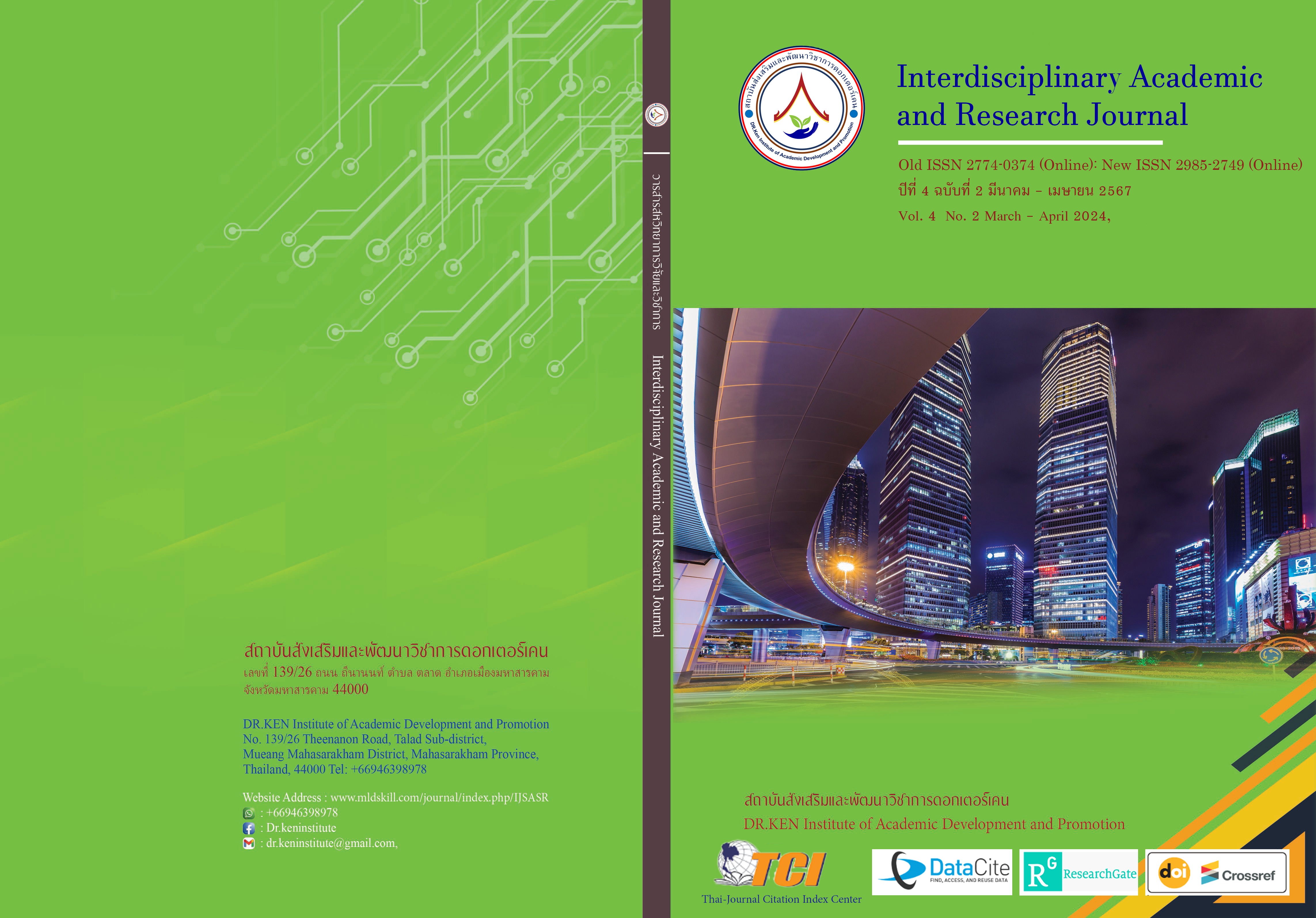Factors Affecting the Service Efficiency of International Freight Forwarding Companies
DOI:
https://doi.org/10.60027/iarj.2024.275054Keywords:
Information Systems; , Service Networks; , Customer Relationship Management; , Service Efficiency; , International Freight Forwarding CompaniesAbstract
Background and Aims: This research aims to explore factors influencing the efficiency of international freight forwarding companies, in responding to rapidly changing market demands. The main objectives are 1) to study opinions on factors affecting company efficiency, and 2) to analyze the relationship between information systems, service networks, and customer relationship management with service efficiency in international freight forwarding businesses. The goal is to assist companies in this industry to improve and develop operational strategies for enhanced efficiency.
Methodology: This quantitative research conducted surveys using questionnaires to analyze the relationship between various factors and the service efficiency of international freight forwarding companies. A purposive sampling of 385 participants was used, collecting data via Google Forms distributed through online networks. The IOC value was 0.67, and Cronbach's Alpha was 0.72. Descriptive statistics were used to explore demographic characteristics and assess the importance of service factors, utilizing means and standard deviations for summarizing basic data. Inferential statistics focused on correlation analysis, employing correlation coefficients and P-values to examine relationships and statistical significance, affirming the role of information systems, service networks, and customer relationship management in service efficiency.
Results: The study found that (1) the general demographic of the 385 respondents was predominantly male, aged 21-30, at officer level, in the service industry sector, belonging to large-sized organizations, and involved in more than 15 import-export transactions per month; (2) significant factors for the service efficiency of international freight forwarding companies included information systems, service networks, and customer relationship management, all highly important for service efficiency; (3) information systems, service networks, and customer relationship management positively correlated with enhancing service efficiency.
Conclusion: The research indicates that key factors in the business of international freight forwarding companies, such as information systems, service networks, and customer relationship management, have a positive relationship with company service efficiency.
References
ณัฐวัฒน์ จันทรวงศ์ และประสิทธิ์ จิระนันทกุล. (2567). ปัจจัยที่ส่งผลต่อความได้เปรียบทางการแข่งขันของธุรกิจตัวแทนขนส่งสินค้าระหว่างประเทศ. รายงานวิจัย มหาวิทยาลัยเทคโนโลยีราชมงคลกรุงเทพ.
วรัญญู วงศ์สุรวัฒน์. (2565). บทบาทของโลจิสติกส์ต่อเศรษฐกิจไทย. วารสารบริหารธุรกิจ มหาวิทยาลัยธรรมศาสตร์, 39(2), 145-158.
ศุภกิตต์ บุญชู และ ไพศาล มโนราษฎร์ (2566). ปัจจัยที่ส่งผลต่อความยั่งยืนของธุรกิจตัวแทนขนส่งสินค้าระหว่างประเทศ. วารสารวิชาการมหาวิทยาลัยราชภัฏพระนครศรีอยุธยา, 12(1), 21-32.
ศุภชัย ศรีหล้า. (2565). โลจิสติกส์: การจัดการและกลยุทธ์. กรุงเทพฯ: สำนักพิมพ์แห่งจุฬาลงกรณ์มหาวิทยาลัย.
สุภชัย สุขะพิทักษ์กุล. (2566). การบริหารความสัมพันธ์กับลูกค้า (CRM) กับประสิทธิภาพการดำเนินงานของธุรกิจตัวแทนรับขนส่งสินค้าระหว่างประเทศ. วารสารวิชาการมหาวิทยาลัยราชภัฏสวนดุสิต, 11(1), 1-12.
สุภาภรณ์ อินทกุล และอรุณศรี ศรีสว่าง. (2565). ปัจจัยที่ส่งผลต่อความสำเร็จของธุรกิจตัวแทนขนส่งสินค้าระหว่างประเทศ. วารสารบริหารธุรกิจ มหาวิทยาลัยเกษตรศาสตร์, 42(2), 1-14
อมรา ดอกไม้ และศุภลักษณ์ ศรีวิไลย. (2564). ปัจจัยที่ส่งผลต่อการเพิ่มประสิทธิภาพการให้บริการของธุรกิจตัวแทนขนส่งสินค้าระหว่างประเทศ. วารสารการจัดการธุรกิจ มหาวิทยาลัยธรรมศาสตร์, 43(1), 1-15.
Agility Insights. (2022). Emerging Markets Logistics Index (2022). Retrieved from https://www.agility.com/en/emerging-markets-logistics-index/.
Blanchard, K., & Bowles, S. (2018). Raving Fans: A Revolutionary Approach to Customer Service. HarperCollins.
Bowersox, D.J., Closs, D.J., & Cooper, M.B. (2019). Supply Chain Logistics Management. McGraw-Hill Education.
Branch, A.E., & Roberson, C.B. (2019). Export Practice and Management. Routledge.
Chopra, S., & Meindl, P. (2016). Supply Chain Management: Strategy, Planning, and Operation. Pearson Education.
Christopher, M. (2016). Logistics & Supply Chain Management. Pearson Education.
Cochran, W. G. (1953). Sampling Techniques. 3rd edition. John Wiley & Sons.
Coyle, J.J., Novack, R.A., & Gibson, B.J. (2020). Transportation: A Global Supply Chain Perspective. Cengage Learning.
Creswell, J.W. (2014). Research Design: Qualitative, Quantitative, and Mixed Methods Approaches. 4th edition. SAGE Publications.
George, D., & Mallery, P. (2003). SPSS for Windows step by step: A simple guide and reference. 11.0 update. 4th edition. Boston: Allyn & Bacon.
Heskett, J.L., Sasser, W.E., & Schlesinger, L.A. (2015). Service Profit Chain: How Leading Companies Link Profit and Growth to Loyalty, Satisfaction, and Value. Free Press.
Kotler, P., & Keller, K.L. (2016). Marketing Management. Pearson Education.
Mangan, J., Lalwani, C., & Lalwani, C.L. (2016). Global Logistics and Supply Chain Management. John Wiley & Sons.
Murphy, P.R., & Knemeyer, A.M. (2018). Contemporary Logistics. Pearson.
Parasuraman, A., Zeithaml, V.A., & Berry, L.L. (1988). SERVQUAL: A multiple-item scale for measuring consumer perceptions of service quality. Journal of Retailing, 64(1), 12-40.
Peppers, D., & Rogers, M. (2016). Managing Customer Relationships: A Strategic Framework. John Wiley & Sons.
Reichheld, F.F., & Teal, T. (1996). The Loyalty Effect: The Hidden Force Behind Growth, Profits, and Lasting Value. Harvard Business School Press.
Thai International Freight Forwarders Association (TIFFA). (2023). Annual Report on Thai Freight Forwarding Industry. Retrieved from https://www.tiffa.org/annual-report-2023.
Downloads
Published
How to Cite
Issue
Section
License
Copyright (c) 2024 Interdisciplinary Academic and Research Journal

This work is licensed under a Creative Commons Attribution-NonCommercial-NoDerivatives 4.0 International License.
Copyright on any article in the Interdisciplinary Academic and Research Journal is retained by the author(s) under the under the Creative Commons Attribution-NonCommercial-NoDerivatives 4.0 International License. Permission to use text, content, images, etc. of publication. Any user to read, download, copy, distribute, print, search, or link to the full texts of articles, crawl them for indexing, pass them as data to software, or use them for any other lawful purpose. But do not use it for commercial use or with the intent to benefit any business.
















.png)


